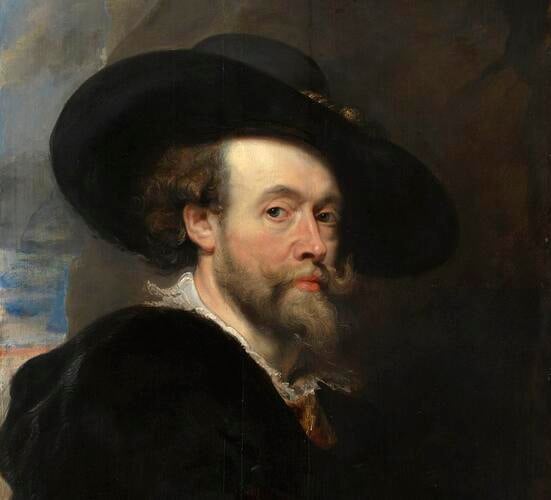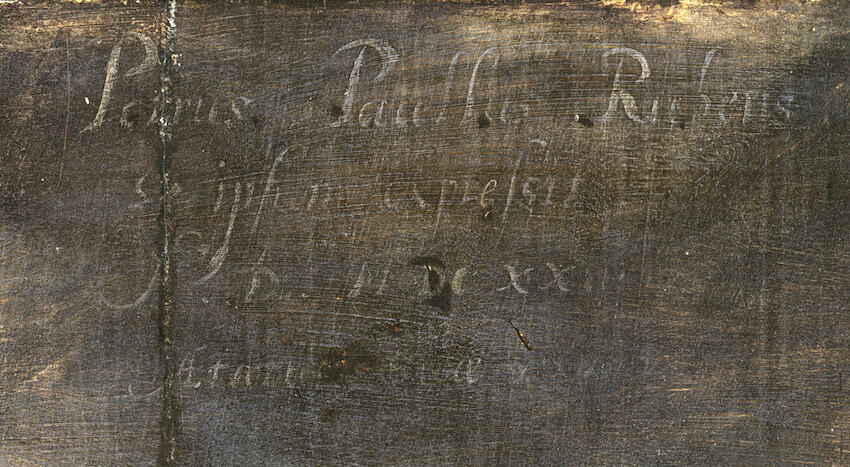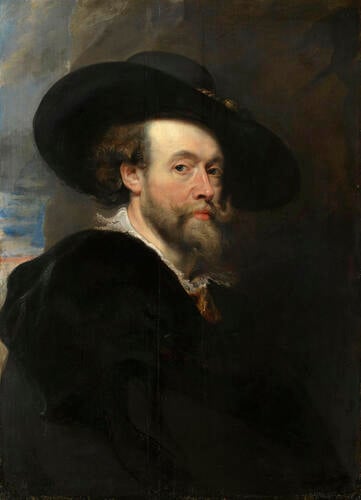-
1 of 253523 objects
Self-Portrait Signed and dated 1623
Oil on panel | 85.7 x 62.2 x 0.5 cm (support, canvas/panel/stretcher external) | RCIN 400156

Sir Peter Paul Rubens (Siegen 1577 - Antwerp 1640)
A Self-Portrait Signed and dated 1623

Sir Peter Paul Rubens (Siegen 1577 - Antwerp 1640)
Self-Portrait Signed and dated 1623



-
This painting seems to have been something of a face-saver. In 1621 Rubens supplied Lord Danvers with a Lion Hunt (now lost), a studio work, not knowing that it was intended for Charles, Prince of Wales. Danvers had it sent back as ‘a peese scarse touched by his own hand’. Rubens seems to have planned with Lord Danvers to make a peace offering to the Prince the moment he realised his mistake. Later Rubens claimed that he was concerned at the arrogance of sending a self portrait under these circumstances: ‘it did not seem fitting to send my portrait to a prince of such high rank, but he overcame my modesty’ (Rubens, letter of 10 January 1625; to Palamède de Fabri, Sieur de Valavez; 1582-1645). The most important thing, however, was that the work should be executed by Rubens and not his assistants: Lord Danvers wrote to William Trumbull in Brussels, asking ‘for his owne picture made originall and every part of it wrought with his owne hand’ (letter of 18 December 1622). Danvers adds in the same letter that this is a self portrait ‘which I heare hee hath made alreadie’; it is difficult to know if this means that Rubens redirected an existing (obviously recent) self portrait, or whether enough progress had been made on the portrait which Danvers himself instigated (through some previous, now lost, instruction) for word to get out that it was ‘made alreadie’. Whatever the explanation, the portrait is signed and dated 1623 and seems to have arrived in London in that year.
This is an interesting piece of self-promotion; it does not advertise Rubens’s invention, figure drawing or story-telling, important elements of his art. Instead we see purely pictorial qualities at their most intense: contrast of light and dark, with shades of deep black and a softly luminous face; strong accents of colour on the face and sky (again contrasting with the areas of black); variations of paint application from thinly scrubbed areas in the background, where brown underpaint shows through, to the thick, mobile rivers of oil paint, drawn by the brush, over the face. Rubens’s ‘owne hand’ is obviously and everywhere at work.
Rubens is portrayed as a courtier and diplomat, wearing sombre – but fashionable and expensive – black clothing. He carries no obvious attributes alluding to his profession, although he does wear a gold chain, which since the mid- sixteenth century had come to symbolise an artist’s success and wealth. However, unlike the gold chain prominently worn by Titian in both his surviving self-portraits, here only a small glimmer of gold can be seen beneath the sitter’s black cloak. Rubens received a number of gold chains during his career, including in 1609 one from the Archdukes Albert and Isabella of Austria and in 1623 from Christian IV of Denmark. The black hat worn at an acute angle, while fashionable, also served to conceal the artist’s hairline, which, as his self- portrait in the Galleria degli Uffizi of c.1615 demonstrates, had begun to recede.
The objects in the background of this portrait could be described as ‘a rock and a reddening sky’, which, in Latin, would read, Petrus et caelum rubens. It has been suggested that the artist included them as a play on his own name (reinforcing the Latin signature), or indeed that the whole portrait depicts a shame-faced, blushing or rubens Rubens.
By 1639, the picture was hanging in the ‘Litle roome Betwene Withdrawing roome: als called the Breakfast Chamber and the longe gallorie’ alongside self-portraits by Van Dyck and Daniel Mytens. This room was next to the King’s Bedchamber and would likely have been seen by the king on a daily basis.
Signed, dated and inscribed along top right margin:Petrus Paullus Rubens / se ipsum expressit / A.D MDCXXIII / Aetatis Suae XXXXV
Text adapted from Bruegel to Rubens: Masters of Flemish Painting, London, 2007, and Portrait of the Artist, London, 2016Provenance
Commissioned by Henry Danvers, Earl of Danby, as a present for Charles I when Prince of Wales; recorded in the Little Room near the Long Gallery at Whitehall in 1639 (no 2); sold for £16 from St James's Palace to Edward Bass and others on 19 December 1651 (no 250); recovered at the Restoration and listed in the Passage at Whitehall in 1666 (no 268) and again in 1688; in the Staircase at Kensington Palace in 1700 (no 37); in store there in 1710 (no 57); in the Crimson Damask Cabinet at St James's Palace in 1720; in the Queen's Dressing Room at Buckingham Palace in 1790; evidently borrowed by George IV to hang in the Rose Satin Room at Carlton House, where it is recorded in 1816 (no 112) and appears in Pyne's illustrated 'Royal Residences' of 1819 (RCIN 922180); taken to the 'Rubens Room' at Windsor Castle
-
Creator(s)
Acquirer(s)
-
Medium and techniques
Oil on panel
Measurements
85.7 x 62.2 x 0.5 cm (support, canvas/panel/stretcher external)
113.3 x 89.2 x 12.5 cm (frame, external)
Other number(s)
CWLF : White, C., 2007. The Later Flemish Pictures in the Collection of Her Majesty the Queen – CWLF 61Bibliographic reference(s)
Rubens: Portraits Princiers Cat. 49
Alternative title(s)
Portrait of the Artist
Self-portrait
Sir Peter Paul Rubens (1577-1640)
Sir Peter Paul Rubens (1577-1640), aged 45